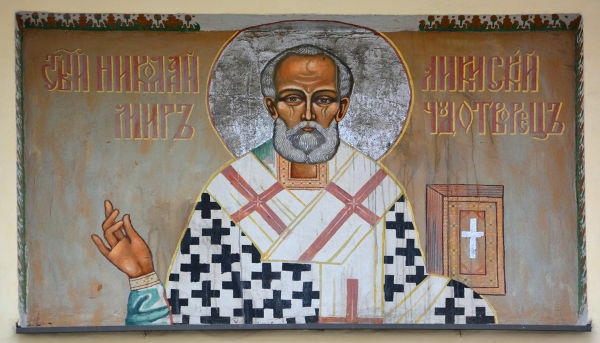One of the most popular Christmas figurines is the Santa Claus, a bearded and paunchy old man who wears red. In the Christmas tradition, Santa Claus is the character who brings presents for well-behaved children on Christmas Eve. Christmas. The good old man is known for flying in his sleigh pulled by eight reindeer, his helpers in the task of delivering gifts to every home.
The legend says that Santa Claus goes from house to house, goes down the chimney and puts the presents inside socks, which are deposited near the fireplace, or under the Christmas tree. The legend also states that Santa Claus resides in the North Pole, but other versions of the story claim that it resides in the Lapland, region located in the far north of Finland.
Origin of Santa Claus
The historical origin of Santa Claus is directly related to St. Nicholas of Mira, also called Nicholas Thaumaturgist, a Christian bishop who lived between the 3rd centuries d. Ç. and IV d. Ç. St. Nicholas lived in Asia Minor (a region currently corresponding to Turkey) and was known for his generosity. This religious was the son of a wealthy family and, after the premature death of his parents, he inherited the wealth of his family. He then started to use the inheritance to distribute gifts to the poor, especially to orphaned children.
Among St. Nicholas' acts of charity and generosity, one episode in particular became very famous. Once, St. Nicholas met a very poor man who had three daughters. This man's daughters did not have the dowry to be able to marry and therefore ran the risk of becoming prostitutes in order to survive. St. Nicholas, then, donated dowries to each one of them to prevent them from entering the path of prostitution.

St. Nicholas was a bishop who was known for being charitable and helping poor children and orphans.*
St. Nicholas' fame within the Catholic Church is very great. The figure of Santa Claus is very similar to the description of this bishop: an old man with a white beard and red clothes. Devotion to St. Nicholas is very strong in some places, such as the Italian city of Bari. Furthermore, this Catholic saint became the patron saint of the poor, the orphans, and some nations such as Greece and Russia.
The figure of Santa Claus, however, does not refer only to the Christian figure of St. Nicholas. There are similarities between this character and Odin, the most powerful god of Norse religious belief. In Norse tradition, Odin is represented in the same way as Santa Claus: a bearded, gray-haired old man.
Also access:Learn more about Norse Mythology
According to Norse and German belief, Odin (called Wotan by the Germans) was responsible for delivering gifts to people during the Yule (or Jól), a festival that took place during the winter solstice among the Norse. According to legend, to accomplish this task, Odin rode his eight-legged horse, Sleipnir. Here we have a clear reference to Santa's eight reindeer. In addition, Sleipnir, like the reindeer, flew over the skies to deliver gifts.
Do not stop now... There's more after the advertising ;)
The Norse believed that Odin went from house to house delivering toys and sweets to children. To make this happen, Nordic children left their boots near the chimneys and filled them with hay or carrots so that Sleipnir could feed. In return, Odin filled his boots with treats. And, of course, Odin entered every house through the chimney!
In the Northern Hemisphere, there was a modernization of the myth involving this Norse god: the children of today, instead of leaving boots near the chimney, they leave socks for Santa Claus to place gifts in them.
This association between Odin and São Nicolau to the figure of Santa Claus was the result of the Christianization suffered by Northern Europe from the 10th century onwards. Yule, a festival that took place around December 21, for example, was replaced by Christmas, celebrated on December 25th. The image of Odin, the one who delivered gifts to children, was associated with St. Nicholas, a figure in Christian tradition.
The belief in Santa Claus came to North America through Dutch immigrants, who believed in sinterklaas (notice the similarity of the name to Santa Claus), a figure associated with St. Nicholas. These immigrants were part of the group that settled in New Amsterdam, now known as New York. The figure of Santa Claus in the United States was, then, a legacy left by the Dutch.
Also access: Learn about another important celebration of the Christian calendar
Santa Claus representation

The modern representation of Santa Claus became popular through a Coca-Cola advertising campaign.**
The current image of Santa Claus comes from a poem published by Clement Clarke Moore in the first half of the 19th century. The poem became known as “A Visit from Saint Nicholas” (A Visit of St. Nicholas), well known also as “Twas the Night Before Christmas” (It's Christmas Eve).
The image of Santa Claus that we currently have was the result of an advertising campaign carried out by Coke in the 1920s and 1930s. These advertisements were a great success and consolidated the current image of Santa Claus as an old man, paunchy, bearded and gray who wears red.
*Image credits: Meunierd and Shutterstock
**Image credits: Sergey Kohl and Shutterstock
By Daniel Neves
Graduated in History


